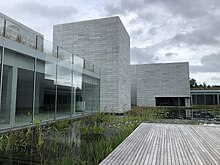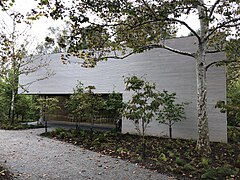Glenstone
 | |
 | |
| Established | 2006 |
|---|---|
| Location | Potomac, Maryland, United States |
| Coordinates | 39°03′42″N 77°15′09″W / 39.061703°N 77.252595°W |
| Type | Art museum |
| Collections | Contemporary art |
| Collection size | 1,300 |
| Founder | Mitchell Rales |
| Curator | Emily Wei Rales |
| Architect | Charles Gwathmey (2006 building) and Thomas Phifer (2018 expansion) |
| Public transit access | |
| Website | glenstone |
Glenstone is a private contemporary art museum in Potomac, Maryland, 15 miles (24 km) from downtown Washington, D.C. The museum's exhibitions are drawn from a collection of about 1,300 works from post-World War II artists around the world. It is noted for its setting in a broad natural landscape.
The museum was developed and financed by billionaire American businessman Mitchell Rales, and is curated by Emily Wei Rales. Artists in Glenstone's collection are required to have already been exhibited for at least 15 years. First opened in 2006 in a building designed by Charles Gwathmey, the museum has been expanded several times between 2013 and 2018 on its 230-acre (93 ha) campus. Its largest expansion was opened to the public on October 4, 2018, with outdoor sculpture installations, landscaping, and the introduction of a new museum complex called the Pavilions designed by Thomas Phifer. In 2019, Glenstone added an environmental center with exhibits on recycling, composting, and reforestation.
Glenstone has been compared to other private museums such as the Frick Collection and The Phillips Collection, and has received generally positive reviews in the press. The museum is open, free to the public, via online booking.
History
In 1986, billionaire American businessman Mitchell Rales purchased property in Potomac, Maryland, in order to build a home. Starting in 1990 Rales began collecting art for that home.[1] Following a near-death accident on a helicopter trip in Russia, Rales decided to take on a philanthropic project, which became the establishment of a private contemporary art museum.[2] Built on land that was formerly a fox hunting club, Glenstone is named for the nearby Glen Road, and because of stone quarries located in the vicinity. Located 15 miles (24 km) from downtown Washington, D.C., the museum's initial 30,000-square-foot (2,800 m2) Modernist limestone gallery opened in 2006, and admitted visitors two days a week. In its first seven years, the museum admitted only 10,000 visitors.[3]

Though several smaller expansions took place in the years after the museum's opening, the largest expansion was announced in 2013 and was completed in 2018, opening to the public on October 4, 2018. With a cost of approximately $219 million, the expansion increased the size of the museum's gallery space by a factor of five, increased the size of the property by 130 acres (53 ha), and included substantial landscaping changes.[4][5] The expansion was named as a "Museum Opening of the Year" by Apollo in 2019.[6]
With the expansion, Glenstone opened to the public, with free tickets available online. It began to admit 450 visitors per day, with the limit imposed to "give lots of space to our visitors, to really give them the time to explore and enjoy", according to Rales.[7] In the year following the expansion, Glenstone admitted nearly 100,000 visitors.[8]
After 2018, Glenstone continued to acquire adjacent properties, including lots containing residential homes.[9][10] Speaking on Public Radio Tulsa's Museum Confidential program in 2019, curator Emily Wei Rales said that future plans do not include substantial expansion, and will likely be limited to "one or two smaller buildings to house artworks, maybe in the woods, maybe on an adjoining property". She also mentioned potential plans to build a conservation lab on the campus.[11]
To encourage the usage of public transportation, Glenstone successfully lobbied Montgomery County to add a bus stop near its campus. The museum admits visitors without tickets who arrive on public buses.[5]
Collection and exhibitions
The museum's collection of about 1,300 post-World War II works from around the world consists of paintings, single-artist installations, video installations, sound installations, and both indoor and outdoor sculptures, totaling $1.4 billion in assets.[5] The collection contains only works by artists who have already exhibited for at least 15 years.[12] As a private art museum, Glenstone has been compared to the Frick Collection and The Phillips Collection.[13]
Many of the museum's large galleries feature only one or two pieces, do not contain explanatory text, and are sparsely furnished.[14][15] While some exhibitions are permanent, the collection rotates through the galleries over time.[16] Pieces from the collection are also loaned to public institutions both domestically and internationally.[1]
The museum's staff is made up of recent university graduates, including some in postgraduate programs, through its Emerging Professionals Program, a two-year program for aspiring curators. Staff members are stationed in the galleries to answer questions from visitors about the art.[17]
In 2018, the introduction of the Pavilions expansion debuted single-artist installations and exhibitions from artists Cy Twombly, Robert Gober, Pipilotti Rist, Charles Ray, On Kawara, Martin Puryear, Michael Heizer, Lygia Pape, Brice Marden. Other artists who have been on display at Glenstone have included Roni Horn, Alexander Calder, Ruth Asawa, David Hammons, Alighiero Boetti, Kerry James Marshall, Shirin Neshat, Rirkrit Tiravanija, and Mark Rothko.[18][19][20][21][22]
Architecture
Glenstone is noted for its peaceful natural setting, consisting of a cluster of galleries and other buildings set in a large 230-acre (93 ha) wooded campus. The museum buildings are located toward the center of the campus, and visitors approach the galleries from gravel parking lots via a pathway through the property that is about one-third mile (0.5 km) long. In designing the campus, Glenstone's founders made an effort to establish a tranquil experience, leading them and art critics to refer to the museum as part of the "slow art" movement.[23]
Buildings
The original Glenstone building opened in 2006 and was designed by American architect Charles Gwathmey of Gwathmey Siegel & Associates Architects. The building is a 30,000-square-foot (2,800 m2) modernist limestone structure with 9,000 feet (2,700 m) of gallery space, located on 100 acres (40 ha) of land.[24] The 2018 expansion added 50,000 square feet (4,600 m2) of gallery space in a 204,000-square-foot (19,000 m2) museum structure called the Pavilions, designed by American architect Thomas Phifer. Mitchell and Emily Wei Rales have mentioned several buildings as particular influences on the design: the Ryoan-ji Zen temple in Kyoto, Japan, the Menil Collection in Houston, and Louisiana Museum of Modern Art in Denmark.[23] The Pavilions is built of 6-foot-long (1.8 m) precast concrete blocks that were poured during different seasons to produce variable coloring. Though it is one building, the Pavilions is meant to appear as multiple separate buildings from a distance. The structure contains eleven galleries connected by glass-enclosed walkways, with windows made of 30-foot (9.1 m) panels of glass. The galleries make heavy use of natural light through clerestories, oculi, and skylights.[19][4] Regarding the architectural approach to the Pavilions, Emily Rales said, "we knew we wanted these discrete spaces where you could essentially enter into another world that happens to be an art installation".[11]
Glenstone's 2018 expansion was a "critic's choice" in The Wall Street Journal's review of the best architecture of 2018, with Julie V. Iovine writing that Glenstone's architecture takes an approach "that offers a sequence of events revealed gradually with constantly shifting perspectives, as opposed to classic modernism’s tightly controlled image of architecture as geometric tableau".[25]
In 2019, Glenstone opened a 7,200-square-foot (670 m2) environmental center on its campus. The building contains self-guided exhibits about recycling, composting, and reforestation.[26]
-
Café
-
Pavilions
-
Pavilions complex
-
Pavilions interior courtyard panorama
Landscape
The Pavilions is built around the Water Court, an 18,000-square-foot (1,700 m2) water garden containing thousands of aquatic plants such as waterlilies, irises, thalias, cattails, and rushes. The Water Court's design was inspired by the reflecting pool at the Brion Cemetery in northern Italy.[19] Referring to the way the museum returns visitors to the Water Court, Samuel Medina wrote for Metropolis, "Art isn't the heart of the Glenstone Museum, which opened in October -- water is".[27] Pulitzer Prize-winning critic Sebastian Smee wrote of the Water Court:
It’s as if you’ve entered a beautiful sanctuary, possibly in another hemisphere, maybe another era. Although you’ve descended, you actually feel a kind of lift, a buoyancy, such as what birds must feel when they catch warm air currents. You exhale. You feel liberated from everyday cares. You’re ready for the art.[13]
The expansion also added 130 acres (53 ha) of land to the campus, a landscape largely composed of woodland and wildflower meadows that was designed by landscape architect Peter Walker. The effort included the planting of about 8,000 trees, the transplanting of 200 trees, and the restoration of streams that flowed through the campus.[28][29] This outdoor space hosts large art installations by artists including Jeff Koons, Félix Gonzalez-Torres, Michael Heizer, and Richard Serra.[12]
Reception
In a review for The Washington Post in 2018, Philip Kennicott wrote that Glenstone is a "must-see" museum and that its creators successfully "integrate art, architecture, and landscape". Referring to the natural setting of the museum, he wrote that "everything is quietly spectacular, with curated views to the outdoors that present nature as visual haiku". Kennicott tempered his review by mentioning that the museum's distinctive architecture and layout continually confront visitors with "strange visions" that will make it "interesting to see how it is received".[14]
Kriston Capps of Washington City Paper called Glenstone's 2018 expansion successful and enchanting, with a sublime viewing experience. He wrote that the museum's collection excels in its focus around conventional paintings, sculptures, and installations, but excludes more modern media, such as video or performance art. With respect to this conservative focus, Capps wrote, "Glenstone is not promoting equity, addressing inequality, or solving accessibility — not yet anyhow."[5]
In Washingtonian, Dan Reed praised Glenstone's suburban setting, saying it "has little in common with the crowded downtown art meccas", and describing it as soothing, contemplative, and stunningly landscaped.[15]
Writing for the National Review, Brian T. Allen described Glenstone as "a gift to the public of rare size and consequence" and wrote that it "is a huge success on many levels, but among its triumphs is fashioning a mood and space to look intently and even to fall in love with art that most will be disposed to find difficult, forbidding, or inscrutable." Regarding the landscape, Allen wrote, "Getting people out of their cars for the long walk to the exhibition spaces creates a time of orientation and decompression. Few museums can even try this because they don’t have the land."[16]
Sebastian Smee wrote in The Washington Post about Glentone's potential to appeal to some types of visitors, but not others. Calling it "the most exciting new private museum in America", Smee wrote that for some visitors, "the Glenstone experience can feel, at least initially, a little weird. A little too...controlling." He went on to say that the museum "wants you to have your own experience" and "proposes that art should not be glibly explained away by wall labels but experienced and reflected upon."[13]
The Washington Post's dance critic, Sarah L. Kaufman, wrote that Glenstone exhibits many visual works that are relevant and influential to dance, including works by Pipilotti Rist, Jasper Johns, and Sol LeWitt.[30]
Legal dispute
In August 2018, Glenstone Foundation Inc., the foundation that manages the museum, was sued by HITT Contracting, the company that managed the construction of the 2018 expansion, for $24 million to cover cost overruns.[31] In October 2018, Glenstone countersued HITT Contracting for $35.9 million, claiming that the project was over budget and that construction issues had delayed the expansion's opening.[32][33][34]
References
- ^ a b Art Wealth Management : Managing Private Art Collections. Zorloni, Alessia,. [Cham], Switzerland. ISBN 3319242415. OCLC 957318205.
{{cite book}}: CS1 maint: extra punctuation (link) CS1 maint: others (link) - ^ Lipsky-Karasz, Elisa (2017-11-29). "The Most Influential Art Collectors You've Never Heard Of". Wall Street Journal Magazine. ISSN 0099-9660. Retrieved 2019-03-11.
- ^ Vogel, Carol (2013-04-18). "Mitchell and Emily Rales Are Expanding Glenstone Museum". The New York Times. Archived from the original on 2018-09-23. Retrieved 2018-10-01.
- ^ a b Mendelsohn, Meredith (2018-09-27). "Tour the New $200 Million Expansion of One of America's Most Important—and Unknown—Museums". Architectural Digest. Archived from the original on 2018-09-27. Retrieved 2018-10-01.
- ^ a b c d Capps, Kriston (2018-09-27). "The New Glenstone is a Contemporary Art Retreat in the Wilds of Montgomery County". Washington City Paper. Retrieved 2018-10-18.
- ^ "Museum Opening of the Year". Apollo Magazine. 2019-11-15. Retrieved 2019-11-18.
- ^ Kugel, Sara (2019-01-20). "Glenstone, a Maryland museum that blends modern art, nature and contemplation". CBS News. Retrieved 2019-01-21.
- ^ Chen, Nancy (2019-10-03). "Glenstone Museum marks one year since expansion". WJLA. Retrieved 2019-10-05.
{{cite web}}: CS1 maint: url-status (link) - ^ Maake, Katishi (2018-11-15). "Glenstone Foundation buys more land in Potomac near museum". Washington Business Journal. Retrieved 2018-11-22.
- ^ Maake, Katishi (2019-01-07). "Glenstone Foundation gobbles up more property near its museum". Washington Business Journal. Retrieved 2019-01-09.
- ^ a b Gregory, Scott; Martin, Jeff (2019-02-15). "Glenstone: A Labor of Love". Museum Confidential (radio program). Public Radio Tulsa. Retrieved 2019-02-19.
- ^ a b Smee, Sebastian (2018-10-03). "The 10 pieces you must see at Glenstone". Washington Post. Retrieved 2018-10-19.
- ^ a b c Smee, Sebastian (2019-05-29). "Is Glenstone a great art museum or a billionaire couple's folly?". The Washington Post. Retrieved 2019-06-11.
- ^ a b Kennicott, Philip (2018-09-21). "The country's newest must-see museum is meticulous and quietly spectacular". Washington Post. Retrieved 2018-10-18.
- ^ a b Reed, Dan (2018-10-03). "Why Potomac's Expanded Glenstone Is Worth the Trip". Washingtonian. Retrieved 2019-01-05.
- ^ a b Allen, Brian T. (2019-01-19). "Glorious Glenstone: An Immersive Experience of Art in 230 Acres of Natural Beauty". National Review. Retrieved 2019-01-21.
- ^ Edgers, Geoff (2018-09-24). "Meet the very wealthy, very private couple behind Washington's most original museum". Washington Post. Retrieved 2018-10-24.
- ^ Pogrebin, Robert (2018-09-21). "Glenstone, a Private Art Xanadu, Invests $200 Million in a Public Vision". The New York Times. Archived from the original on 2018-10-02. Retrieved 2018-10-01.
- ^ a b c Smee, Sebastian; Higgins, Adrian. "Glenstone: See inside (and outside) D.C.'s newest museum experience". Washington Post. Archived from the original on 2018-10-02. Retrieved 2018-10-01.
- ^ "Glenstone - The Pavilions". www.glenstone.org. Retrieved 2018-10-15.
- ^ Lewis, Catherine P. (2019-04-18). "Things to Do in DC This Weekend: The National Cannabis Festival, a Crawfish Boil, and Celebrating the Marvin Gaye Stamp". Washingtonian. Retrieved 2019-04-21.
- ^ Deng, Audrey (2019-09-25). "Professor Rirkrit Tiravanija in solo exhibit at Glenstone Museum". Columbia University School of the Arts. Retrieved 2019-09-27.
{{cite web}}: CS1 maint: url-status (link) - ^ a b Catherine, Trifiletti (2019-02-28). "Slow Down with Slow Art". Washington Life. Retrieved 2019-03-11.
- ^ Hilburg, Jonathan (2018-09-24). "AN tours the Glenstone Museum's new Pavilions". archpaper.com. Retrieved 2018-10-17.
- ^ Iovine, Julie V. (2018-12-14). "The Best Architecture of 2018: Building for Complex Experiences". The Wall Street Journal. Retrieved 2018-12-16.
- ^ Wright, Charlie (2019-06-10). "Glenstone Museum in Potomac Opens Environmental Center". Bethesda Magazine. Retrieved 2019-06-11.
- ^ Medina, Samuel (2018-12-04). "At Thomas Phifer and Partners' Glenstone Museum, Hidden Facade Details Make a Big Impact". Metropolis. Retrieved 2018-12-06.
- ^ Higgins, Adrian (2018-10-02). "Glenstone's landscaping is as mindful as its artwork". Washington Post. Retrieved 2018-10-17.
- ^ "Reforestation" (PDF). glenstone.org. Glenstone. Retrieved 2019-05-17.
- ^ Kaufman, Sarah (2019-08-23). "Glenstone's connections to dance, now and on the horizon". The Washington Post. Retrieved 2019-08-28.
- ^ Moynihan, Colin (2018-09-06). "Contractor Sues Glenstone Museum Foundation for $24 Million". The New York Times. ISSN 0362-4331. Retrieved 2019-01-05.
- ^ Sernovitz, Daniel S. (2018-09-06). "Contractor sues Glenstone museum for $24 million 'disorganized' expansion planning". Washington Business Journal. Retrieved 2019-01-05.
- ^ Sernovitz, Daniel S. (2018-10-26). "Hitt Contracting accused of bungling Glenstone Museum expansion". Washington Business Journal. Retrieved 2019-01-05.
- ^ Sernovitz, Daniel S. (2018-12-27). "New claim accuses Hitt Contracting of retaliation in Glenstone suit". Washington Business Journal. Retrieved 2019-01-05.




